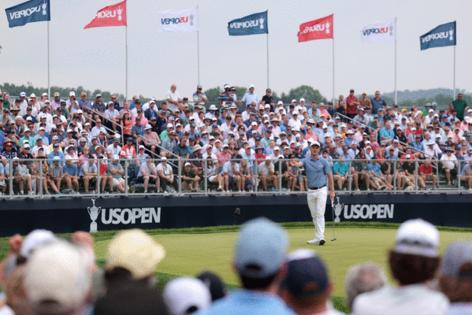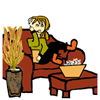Oakmont's torturous greens are frustrating US Open golfers -- and inflating their scores
Published in Golf
PITTSBURGH — It’s hard enough to reach the greens at Oakmont Country Club.
Players must navigate narrow fairways surrounded by thick rough and punishing bunkers.
They then must land approach shots not just on the green, but in particular parts of it, to have any hope of their ball staying on the putting surface.
Players have described the U.S. Open at Oakmont as a grueling mental test — Scottie Scheffler said he couldn’t remember the last time a round took more out of him than on Thursday, when he shot a 73 — and it might get even more challenging when they finally get to putt on the course’s legendary Poa annua greens.
Players are averaging approximately 1.9 putts per green through the first two rounds of the U.S. Open. The PGA Tour average for the season is 1.76.
Oakmont’s pristine greens are lightning-fast — measuring in the upper-14s on the Stimpmeter, a device used to gauge the speed of putting surfaces — and their massive slopes often require players to account for several feet of break.
Sam Burns, the top-ranked putter on the PGA Tour, was just the 106th-ranked putter in the first round of the U.S. Open.
Burns has made more than 20% of his putts from outside 10 feet this season, the best rate on tour. But at Oakmont, he’s had to approach those putts differently.
“A lot of times … you're not really trying to make them, you're just trying to get the speed right and hope that it snuggles up next to the hole,” he said after his round Friday.
He didn’t feel like he learned anything insightful about the greens Thursday, “other than they’re extremely difficult.”
But he figured something out: He was one of the top-five putters in the field Friday on his way to a scintillating 65 that vaulted him to the top of the leaderboard going into the weekend. Play was suspended late Friday as dangerous weather moved in, and several players will need to finish the second round Saturday.
At a course as demanding tee-to-green as Oakmont, players might not win the tournament on the greens — but they can certainly lose it there.
Viktor Hovland was among the 10 worst putters during Round 1, losing more than three strokes on the greens, according to USGA data that tracks strokes gained. His putting was the anchor that pulled him down the leaderboard, despite ranking sixth off the tee and third on approach shots.
A unique aspect of many Oakmont greens particularly frustrated him: the slope from front to back that makes staying below the hole nearly impossible at times.
“Usually, that's a pet peeve of mine,” Hovland said after his round Friday. “I almost automatically think it's a bad hole if it's sloped front to back. Somehow, they make it work here.”
Hovland birdied three holes (Nos. 1, 10 and 12) with that unique slope during his strong second-round 68 Friday to jump to third in the tournament. He ranked in the top 30 on the greens during the second round.
The 14th-ranked player in the world said the importance of lag-putting — long putts that players simply hope to get close to the hole to set up an easier second attempt — “goes up significantly” at Oakmont.
It probably makes lag-putting easier when you drain your first putt of the day from 53 feet, as Hovland did Friday on Hole 10.
Oakmont’s greens might look relatively flat on TV. But the major undulations that make some greens look like topographical maps are more obvious the closer you get to the finely mowed grass.
The USGA perches the pins on the edges of those slopes, so if players don’t reach the same tier as the hole, they may be putting several feet uphill or downhill.
If they are on the same tier and hit their putts just a tad too hard, the ball can go tumbling down and leave them with a longer second putt than their first.
A legacy of challenging greens
Hole 2 showcases the precision required on Oakmont’s greens.
W.C. Fownes Jr., son of Oakmont founder Henry Fownes, would drop a ball on the back of the second green each morning. If it didn’t roll off the putting surface, he’d tell the grounds crews to make the greens faster.
At least, that’s how the legend goes.
Some players on Hole 2 Friday encountered the ghost of Fownes, including a marquee name who had been among the leaders.
Collin Morikawa appeared set for a birdie to move under par when he stood in the fairway just 88 yards from the pin. His approach shot got within feet of the cup, but then it started tumbling down the slope — and just kept trickling farther and farther away.
He wound up 62 feet from the hole and three-putted after missing from less than 4 feet for par.
Morikawa has been one of the 20 worst putters in the field through two rounds, squandering the ball-striking that otherwise would have him in contention.
The difficulty of Oakmont’s greens is quite literally etched in history. The Stimpmeter was reportedly invented by Edward S. Stimpson in response to Gene Sarazen putting a ball off an Oakmont green in the 1935 U.S. Open.
Mental challenge
Oakmont’s vexing greens appear to be taking a toll on players.
Jon Rahm had an excellent first round, shooting 69 in tough afternoon conditions. The former top-ranked golfer in the world and two-time major champion seemed to be the biggest threat near the top of the leaderboard.
But a cataclysmic putting performance doomed him Friday, as he ranked in the bottom 10 of the field on his way to a 75.
“Honestly, I'm too annoyed and too mad right now to think about any perspective,” Rahm said when asked how he felt about that score relative to the difficulty of the course. “Very few rounds of golf I played in my life where I think I hit good putts and they didn't sniff the hole, so it's frustrating.”
©2025 PG Publishing Co. Visit at post-gazette.com. Distributed by Tribune Content Agency, LLC.







Comments